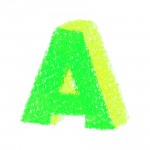Hello,
The other really popular request I get (along with discipline) is how to teach the abcs or alphabet.
A lot of teachers stick to the ABC song, which is fine in itself but there are plenty more things we can do.
I’ve done a quick “5 minute abcs” video for you and I’ll just give a few more tips here:
1. Rather than the letter “names”, try the “sounds”
 It’s usually a good idea to start with the letter “sounds” before the names e.g. the sounds a, b, c as in “hat”, “bug” or “cat” rather than “ay bee see.”
It’s usually a good idea to start with the letter “sounds” before the names e.g. the sounds a, b, c as in “hat”, “bug” or “cat” rather than “ay bee see.”
(This is what we call “phonics“)
Why?
Because this allows the kids to read. Really, really quickly.
Which is pretty cool I think you’ll agree. 🙂
.
2. Try to learn some words *before* the letters
 Babies learn new sounds really, really well.
Babies learn new sounds really, really well.
In fact that’s one of the biggest reasons for learning a language early.
But kids (and adults!) often have a harder time learning individual sounds compared with full words or sentences.
Hence they usually slip back into their native pronunciation.
And it’s really easy to cure this.
Just learn lots of words and sentences *first*, then start chopping them up into individual sounds.
.
3. Lower case before upper case
 Glad you’re on board with learning some words/sentences first, then the letter “sounds” and now it’s time to introduce the letters.
Glad you’re on board with learning some words/sentences first, then the letter “sounds” and now it’s time to introduce the letters.
But which ones? Lower case “small” letters or upper case “capital” letters first?
Well, count how many lower case letters are in this post.
And then count how many capital letters there are.
I hope it’s pretty easy to see which is the most popular!
🙂
These are just a few little ideas to think about.
Do feel free to ask me any questions in the comments (even simple ones are cool) and do check out the “5 minute abcs” video I made for you, it will show you everything you need to get started!
Be genki,
Richard
P.S. If you have kids mixing up things like “b” and “d”, it’s often a good idea to change the order you teach the letters. See the video, it will show the order the UK government recommend to make it the least confusing for the kids!
P.P.S. Some schools will try and make you do things differently. But the really cool thing with Genki Phonics is that it is measurable. So just do one class one their way, and one class the Genki way. It becomes so obvious, even to parents and head teachers, which one works best – it seriously is like magic! They’ll be praising you forever! 🙂



It’s really usefull. I want to practise again all sounds.
thaks for being genki, Richard! I enjoe your tips! angela
Hi Richard.
My kids are up to the phonic /qu/. They read really good!
I taught them only the sounds with gestures- no names and no capital letters.
Now they are starting a new course book. They need to read texts with short questions. Should I start teaching them all the capital letters, so they don’t keep on asking for the sound of the letter every time there is a capital letter in the sentence they are reading?
And about the names of the letters- there are listening tasks that use the names of the letters to tell the pupils what and where to answer. How should I teach the names of the letters?
Phonics was so much fun for me to teach, and for the kids to learn, I hope that starting to work on ‘capitals’ and ‘names’ will take the *magic* away….. Should I?
Obviously I meant:
WON’T take the *magic* away
Also,soon we’ll be introducing the long and short vowels. It’s harder to teach when the kids don’t know the letter’s name… ( or is there another way I don’t know about …?)
Any ideas???
Hi Liora,
Great that the kids are doing so well so far! 🙂
RE long/short vowels: Just work through the Genki Phonics as you’ve been doing and use the gestures to identify the long vs. short vowels. That is way easier and way less confusing that using the letter names. We have the gestures right up until the alternative readings section.
RE Capital letters: As long as you’re working through the phonics in order and putting the lower case letters as the priority then if you look how we do it, we just introduce the capital letters when and where needed. The ones that are the same shape e.g. s and S, we just get the kids to pick them up in the reading, and the ones that are different shapes we get the kids to guess at what they might be, then help them when they get stuck. So no need to worry too much here, unlike the letter names which can be damaging, with the capital letters there’s not that much damage to be done if you’re keeping the lower case letters as the main thing!
RE Names of the letters: Keep this for as late as possible. Some experts say keep them till the full course has finished, but if you really want to do them earlier as long as you’ve got to the “qu” stage then you could introduce them if you want. But of course for best results, keep them for later if you can!
RE the magic!: Capital letters no worries. The letter names, yeah they do kill things a bit as they don’t fit in with the sounds, but by the time you are doing them the kids should be reading ninjas anyway!! 🙂
Thanks for the reply Richard!!!
This really troubled me,and you calmed me down.
Thanks again for being there for us teachers:-)
Liora
Hi Mr. Richard ,
Thank you for for this fascinating way to teach kids . I want to ask you about the phonemic color chart and how we can use it in the classroom to teach kids .
Kawther
Hi Kawther,
You don’t to add the phonemic color chart, it just adds complexity. Keep it simple. Just do regular phonics. It’s easy 🙂
For children who have never heard English, how long (number of lessons) do you recommend they build knowledge of spoken language (words, sentences) before they begin phonics?
Hi Nomita,
Good question! The answer is “As long as possible.”
After all native speaker kids hear thousands of hours before they learn to read!
In an ideal ESL environment where the kids only get to speak English in class then they would have gone through all 100 of the Genki English lessons before doing any reading.
If you can’t hold the parents off for that long, many teachers start phonics after around 30 or 40 of the Genki English lessons.
But the longer you can wait, the better the results!
P.S. I also have my “Phonics First” curriculum, where we start phonics in lesson 1, but that is only for teachers who really know what they are doing and have very little choice over how they teach!
Hi Richard,
100% in agreement with learning lower case letters before upper case. It’s a huge flaw I have long noticed in many “coursebooks” I have worked with. Also, it just results in having to get kids to “unlearn” capitalising every letter of every word they write and confuses the rules of capitalisation.
Keep the great information coming.
Daryl